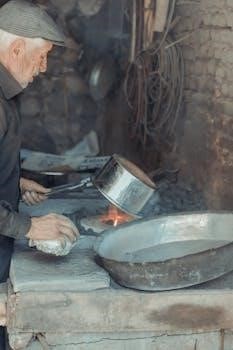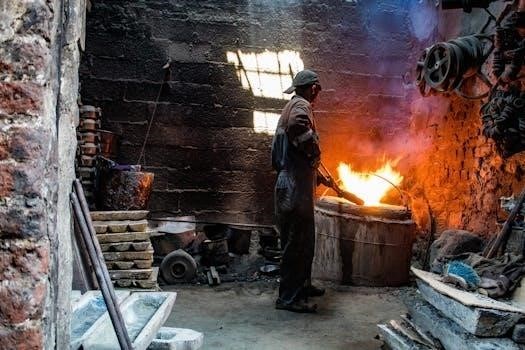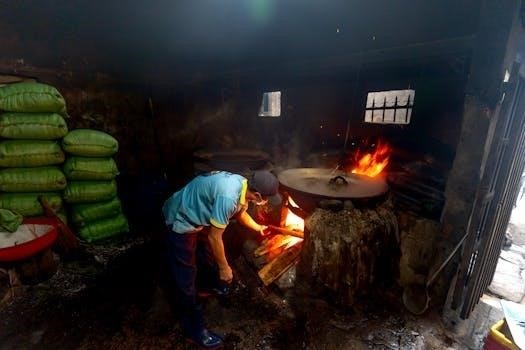
pellet stove manual
Pellet stove manuals are essential guides for safe and efficient operation. These documents, often produced by manufacturers like ComfortBilt and US Stove, provide vital information. They cover installation, usage, and maintenance, ensuring longevity and optimal performance. These manuals are a crucial resource for all pellet stove owners.
Importance of Manufacturer Guidelines
Adhering to manufacturer guidelines is paramount for the safe and effective operation of your pellet stove. These guidelines, meticulously crafted by companies like ComfortBilt, Cleveland Iron Works, and US Stove, provide specific instructions tailored to each model. Ignoring these recommendations can lead to improper usage, reduced efficiency, and potential safety hazards. The manuals detail fuel specifications, including pellet size, density, and BTU requirements, which are crucial for optimal combustion and avoiding damage. Furthermore, manufacturer guidelines outline essential maintenance procedures, helping to prevent costly repairs and extend the lifespan of your stove. These instructions ensure compliance with safety standards and environmental regulations. They also offer troubleshooting advice for common issues. Therefore, carefully reading and following the manufacturer’s instructions is essential for every pellet stove owner to ensure safe, efficient, and reliable operation while also protecting their investment.

Understanding Pellet Stove Operation
Pellet stoves operate by burning compressed wood pellets, providing efficient heating. Understanding the combustion process, fuel feed mechanisms, and airflow is crucial. Manuals offer insights into these operational aspects for optimal performance and safety.
Fuel Quality and Specifications
The quality of pellets significantly impacts the performance and longevity of your pellet stove; Manufacturer manuals, such as those from ComfortBilt, often specify the use of premium hardwood pellets that adhere to Pellet Fuels Institute (PFI) standards. These standards typically include a minimum density of 40 lbs per cubic foot, a diameter between 1/4 and 5/16 inch, and a length not exceeding 1.5 inches. Furthermore, the pellets should have a minimum BTU rating of 8,200 per pound, moisture content below 8% by weight, ash content below 1% by weight, and salt content under 300 parts per million. Using pellets that deviate from these specifications can lead to poor combustion, damage the stove, and even void warranties. Always refer to your specific stove’s manual for precise fuel requirements to ensure safe and efficient operation, avoiding variable quality pellets on the market. Proper fuel ensures the stove performs as designed and provides optimal heat output.
Quick Start Procedures
Pellet stove manuals often include a quick start guide to initiate the heating process safely and effectively. Typically, these procedures begin with ensuring the stove’s dial control is set to the “OFF” position. Next, the user should fill the hopper with the appropriate pellets as specified in the fuel quality section, and securely close the hopper lid. Before plugging in the appliance, it’s vital to confirm that all components are correctly assembled, and all safety precautions outlined in the manual are followed. This initial startup phase might also include steps to prime the auger system by ensuring pellets move into the firepot. Some models may require specific button presses or dial adjustments to start the ignition process. Always consult your specific model’s manual for exact startup procedures. These instructions are crucial to prevent malfunctions and to ensure a smooth, safe first operation of your pellet stove.

Installation and Safety
Proper installation is critical for safe pellet stove operation. Manuals detail safety notices and precautions. They provide instructions for correct setup to prevent hazards. Always follow guidelines to avoid injury or property damage.
Safety Notices and Precautions
Pellet stove manuals emphasize the critical importance of adhering to safety notices and precautions. These documents consistently warn against the use of flammable liquids like gasoline near the appliance. They stress the need to keep viewing and ash removal doors tightly closed during operation to prevent fire hazards. Furthermore, manuals highlight that failure to follow instructions could lead to property damage, bodily injury, or even death. These manuals often include specific warnings about the use of non-approved fuels which could cause damage to the stove and void warranty. Always read and understand the safety section before installing or operating your pellet stove. It’s also crucial to ensure the stove is installed according to the manufacturer’s specifications and local building codes, and to never bypass safety features for any reason. Regular inspections and maintenance are also necessary for safe operation.
Proper Installation Instructions
Pellet stove manuals contain detailed and precise instructions for proper installation, crucial for safe and efficient operation. These instructions often include specific requirements for clearances from combustible materials and the proper connection of venting systems. Manuals emphasize the importance of following the manufacturer’s guidelines and local building codes when installing your appliance. The installation process must be done by a qualified professional to ensure that it’s done safely and correctly. Manuals often include diagrams and step-by-step guides to help ensure the stove is correctly set up. Ignoring these instructions can lead to hazardous conditions, poor performance, and voiding your warranty. Proper installation also includes setting up the stove on a non-combustible hearth and ensuring proper electrical connections. Always refer to the specific model’s manual for accurate instructions.

Maintenance and Troubleshooting
Regular maintenance, as detailed in the manual, is key to a pellet stove’s longevity and efficiency. Troubleshooting sections help address common issues, ensuring safe and reliable operation. Always consult your manual for specific guidance.
Regular Maintenance Procedures
Consistent maintenance is crucial for pellet stove performance and longevity, as outlined in your manual. Routine tasks include emptying the ash pan frequently to prevent buildup and ensure proper airflow. Cleaning the burn pot regularly is also essential to avoid clogs and maintain efficient combustion. Inspecting the venting system for blockages or damage, and cleaning as needed, is vital for safe operation. Pay close attention to the heat exchanger, removing any accumulated ash or debris. Check the gaskets around the doors and hopper, replacing any that are worn or damaged. Lubricate the moving parts as directed in your specific pellet stove manual, to ensure smooth operation. Finally, ensure the hopper is free of obstructions and that the fuel feed system is working correctly. Adhering to the manual’s maintenance schedule will help prevent future problems and ensure your stove works efficiently.
Troubleshooting Common Issues
Pellet stove manuals often include a troubleshooting section to address common problems. If your stove fails to ignite, check the fuel supply and igniter. For poor heat output, ensure proper airflow and that the stove is clean. A smoky burn may indicate a blockage in the venting system or a problem with the air intake. Unusual noises could be caused by loose components or a failing motor. If the stove shuts down unexpectedly, check for error codes and consult your manual. Pellet feed issues can stem from a clogged hopper or faulty auger. Addressing these problems promptly, using the troubleshooting guide, is crucial. Always refer to the manual before attempting repairs. If issues persist, consult a qualified technician. Ignoring these signs can lead to further damage.

Specific Models and Brands
Many brands like ComfortBilt, US Stove, and Enviro offer various pellet stove models. Each model has unique features and specifications detailed in its specific manual. Understanding these differences is important for proper use and maintenance.
Overview of Popular Pellet Stove Models
Several popular pellet stove models stand out in the market, each offering unique features and benefits. The ComfortBilt HP61 is known for its high output and traditional design, making it suitable for basement applications. The ComfortBilt HP22, a popular model, is often mentioned for its performance and efficiency. Brands like US Stove offer a range of models, each with specific capabilities and design aesthetics, ensuring consumers can choose a stove that meets their specific needs. Models from St. Croix are praised for their reliability and performance. The P43 pellet stove is noted for its compact design and ability to deliver up to 43,000 BTU. The Classic Bay 1200 is another model with a proven history of reliable operation. These various models come with detailed manuals to guide owners through safe operation and maintenance. Understanding the features of each model is essential for selecting the right stove for your home.